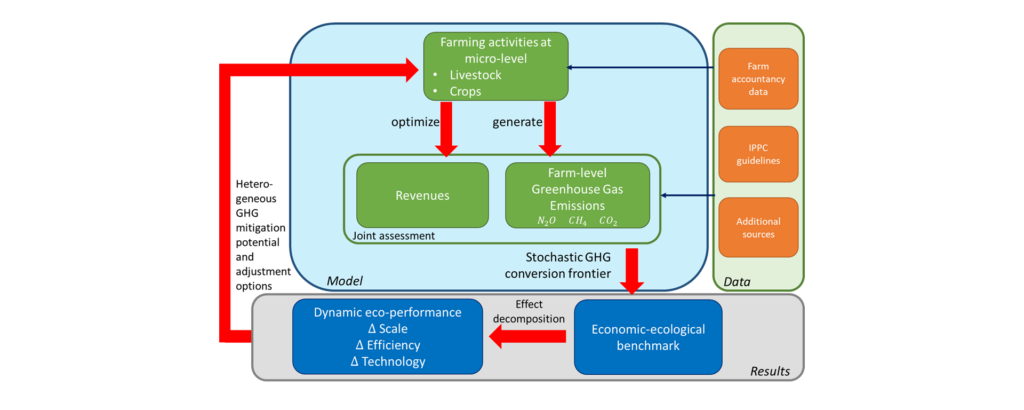Project leaders:
- Thomas Knoke and Elizabeth Gosling, Sebastian Rössert
- Johannes Sauer and Christian Stetter
Technical University of Munich
Update December 2021
Climate change and agriculture are inextricably linked. Agriculture has a crucial role to play in climate change mitigation, but it is also essential that farms remain productive and economically sustainable. Sub-project 4 develops an approach to measure and analyse farm-specific GHG emissions, providing important insights into trade-offs between economic revenues and GHG emissions (Figure 1). We identify considerable potential to reduce GHG emissions of different farm types in Bavaria without incurring economic losses. In a further analysis we evaluate this trade-off for intensive and extensive farms. We show that extensive farms have significantly more potential to save emissions, but the ratio of economic return to GHG emissions is more favourable for intensive farms. Overall we show that climate protection and economic sustainability are not necessarily mutually exclusive.

Voluntary agri-environmental schemes (AES) are increasingly important for the transition towards environmentally and climate-friendly agriculture. However, using an innovative machine-learning algorithm for causal analysis, we found that participation in such schemes rarely has a far-reaching positive effect on a farm’s ecological sustainability (Stetter, Menning, Sauer, 2020). For example, none of the participating farms reduced their GHG emissions, and only around a third reduced their fertiliser use. Land-use diversity did improve slightly on around half of the farms. We uncover spatial patterns (Figure 2) and outline how farms could be better targeted for AES, which could greatly improve the cost-effectiveness of such agri-environmental measures.

Agroforestry is often advocated as a promising strategy for climate adaptation and mitigation in agriculture. These systems, which are not yet common in Bavaria, combine forestry and agriculture to provide important ecosystem services and enhance resilience to extreme weather. Our analysis, however, showed that farmers in Bavaria are generally sceptical about agroforestry. Nevertheless, we found that policy interventions and the occurrence of extreme weather events can significantly increase farmers’ willingness to adopt such systems. The low acceptance of agroforestry was also reflected in the results of a robust land-use optimisation. Here, short rotation coppices (SRC, an agroforestry system where poplar trees are grown for energy production) were missing from the land-use portfolio optimised for risk-averse farmer seeking to maximise profit (this portfolio instead consists of potatoes, sugar beet, winter rapeseed and maize, see Fig. 1A). Our analysis showed that higher woodchip prices are needed to make SRC attractive to risk-averse, profit-oriented farmers. However, if farmers also consider ecological goals (multifunctional perspective, Fig. 1A), a 24% share of SRC is included in the optimised land-use portfolio. This underlines SRC’s potential to reduce a farm’s nitrogen fertiliser and pesticide use, as well as to improve soil carbon storage. Moreover, our results suggest that SRC can greatly reduce the financial loss that farmers incur when switching from a purely economic objective to a multifunctional perspective (Fig. 1B). Consequently, the inclusion of SRC in a diversified farm portfolio can be a cost-efficient strategy to help transition towards multifunctional agriculture in Bavaria. Through a spatial analysis, the optimised arable portfolios could be successfully allocated in an exemplary landscape (Upper Bavaria) (Kloibhofer, 2021).

Goal of the subproject

What are Bavaria’s optimal land use strategies in times of climate change? BLIZ develops possible scenarios for such questions. (Photo: Knoke/Rammig)
We analyze developments in Bavarian land use both from a historical and future perspective. Historical changes in the Bavarian landscape are investigated using remote sensing methods. Based on the forecasts of the climate-sensitive ecosystem model LPJ-GUESS (subproject 1) decisions of farmers and foresters on future land use are simulated.
We are interested in how farmers and foresters allocate their resources (such as land) to different usage options among others. To estimate the distribution of land use options, modern land use models are employed at the level of representative agricultural model farms or for representative model forest holdings. The input information for these models could be productivity and its fluctuations, market price developments, crop failures or calamities in the forest. The analysis of conflicting goals, for example conflicts between productivity and biodiversity or multifunctionality, constitute a substantive part of the research approach. The already existing modeling approaches are extended towards optimization under multiple objectives in order to actively integrate ecosystem services or damages to the environment (for example erosion or excessive use of liquid manure) into the optimization process. The results contrast primarily economically driven as well as multifunctional developments (taking into account ecosystem services) of future land use in Bavaria. Alternative land use options (agroforestry, energy wood plantations) are also evaluated.
